Simulated Negotiation: Analyzing a Collective Agreement Dispute
VerifiedAdded on 2023/06/13
|10
|2002
|349
Case Study
AI Summary
This case study analyzes a simulated negotiation based on the 2018 Auckland rail workers' dispute between the Rail and Maritime Transport Union (RMTU) and Transdev Auckland, focusing on the negotiation of a new Multi-Employer Collective Agreement (MECA). It outlines the steps in the negotiation process, including preparing a business case, considering legal entitlements, and understanding the decision-making structures of each party. The study emphasizes the importance of a process agreement to manage expectations and ensure effective communication. It examines the bargaining positions of the union, distributive and integrative negotiation tactics, and the potential for manipulative and neutral strategies. The analysis also addresses the legality of strikes and lockouts, the role of good faith in bargaining, and provides examples of failures of good faith, concluding that both parties generally observed good faith during the dispute, despite the strike action.
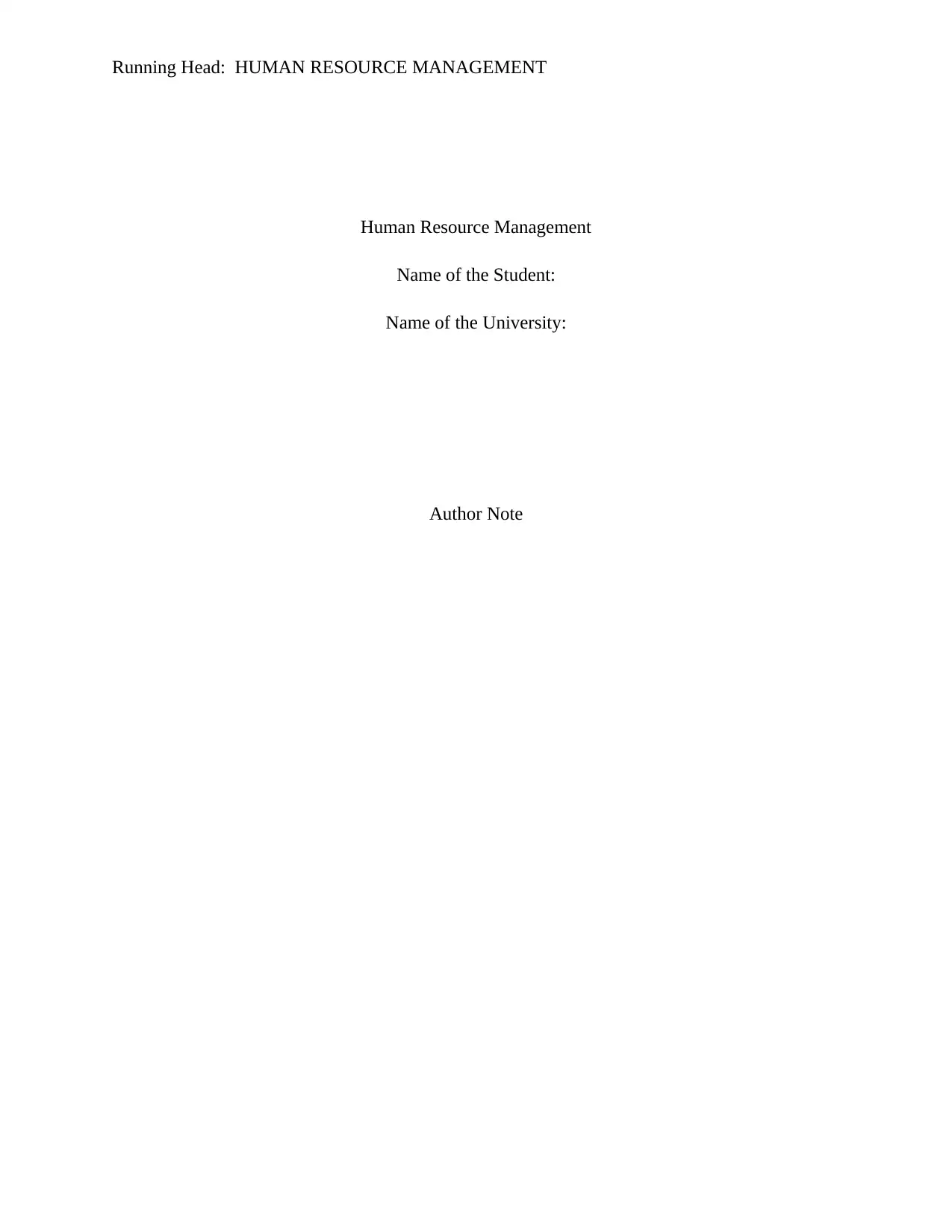
Running Head: HUMAN RESOURCE MANAGEMENT
Human Resource Management
Name of the Student:
Name of the University:
Author Note
Human Resource Management
Name of the Student:
Name of the University:
Author Note
Paraphrase This Document
Need a fresh take? Get an instant paraphrase of this document with our AI Paraphraser
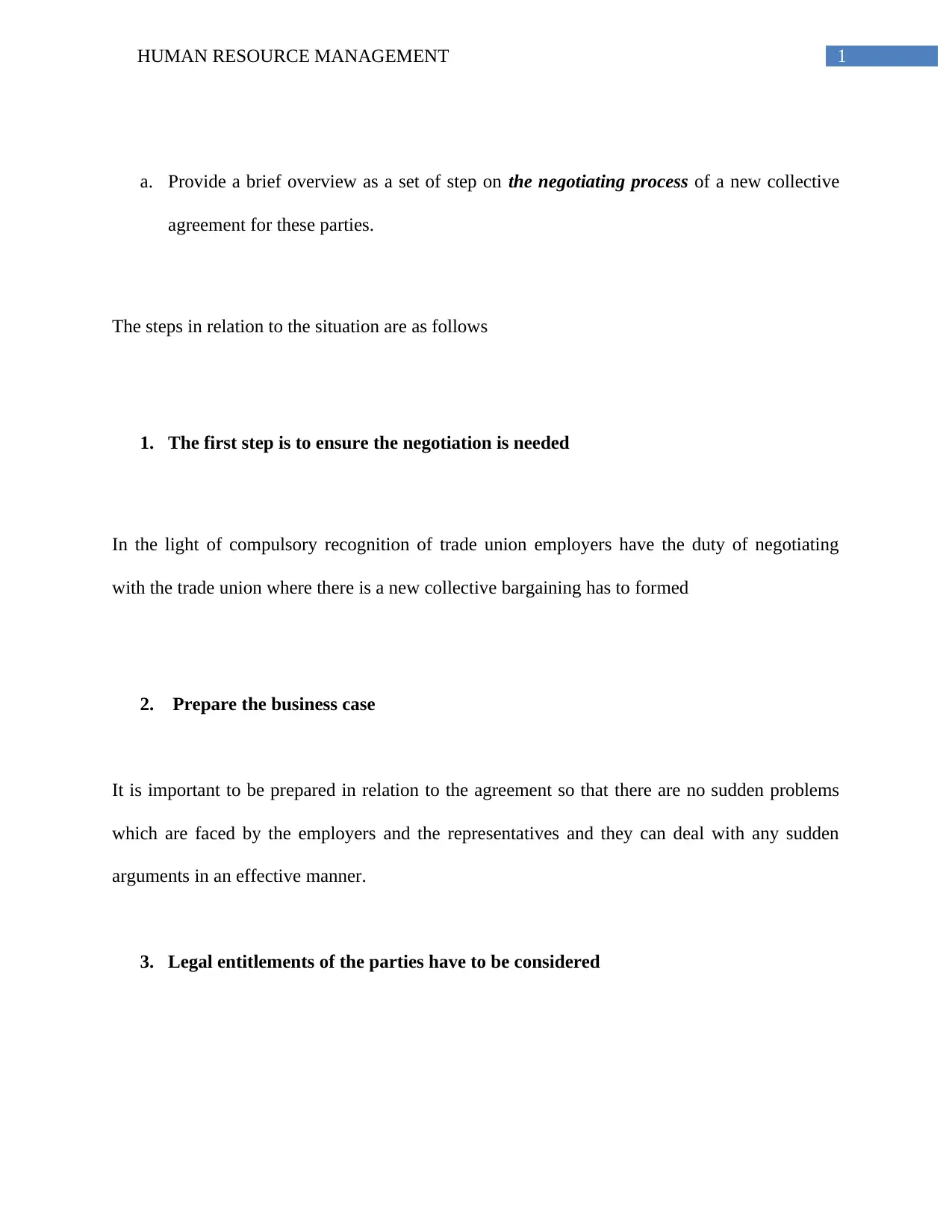
1HUMAN RESOURCE MANAGEMENT
a. Provide a brief overview as a set of step on the negotiating process of a new collective
agreement for these parties.
The steps in relation to the situation are as follows
1. The first step is to ensure the negotiation is needed
In the light of compulsory recognition of trade union employers have the duty of negotiating
with the trade union where there is a new collective bargaining has to formed
2. Prepare the business case
It is important to be prepared in relation to the agreement so that there are no sudden problems
which are faced by the employers and the representatives and they can deal with any sudden
arguments in an effective manner.
3. Legal entitlements of the parties have to be considered
a. Provide a brief overview as a set of step on the negotiating process of a new collective
agreement for these parties.
The steps in relation to the situation are as follows
1. The first step is to ensure the negotiation is needed
In the light of compulsory recognition of trade union employers have the duty of negotiating
with the trade union where there is a new collective bargaining has to formed
2. Prepare the business case
It is important to be prepared in relation to the agreement so that there are no sudden problems
which are faced by the employers and the representatives and they can deal with any sudden
arguments in an effective manner.
3. Legal entitlements of the parties have to be considered
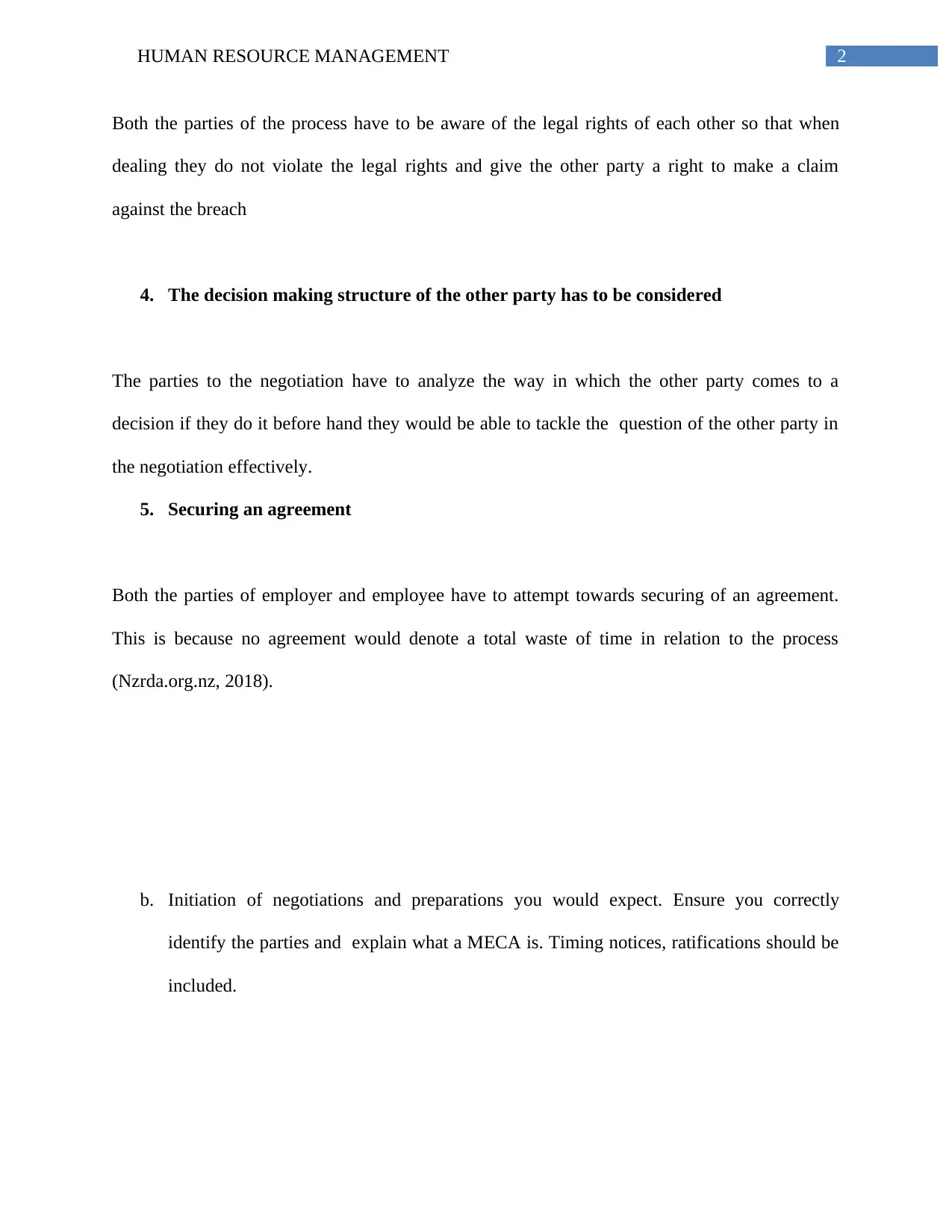
2HUMAN RESOURCE MANAGEMENT
Both the parties of the process have to be aware of the legal rights of each other so that when
dealing they do not violate the legal rights and give the other party a right to make a claim
against the breach
4. The decision making structure of the other party has to be considered
The parties to the negotiation have to analyze the way in which the other party comes to a
decision if they do it before hand they would be able to tackle the question of the other party in
the negotiation effectively.
5. Securing an agreement
Both the parties of employer and employee have to attempt towards securing of an agreement.
This is because no agreement would denote a total waste of time in relation to the process
(Nzrda.org.nz, 2018).
b. Initiation of negotiations and preparations you would expect. Ensure you correctly
identify the parties and explain what a MECA is. Timing notices, ratifications should be
included.
Both the parties of the process have to be aware of the legal rights of each other so that when
dealing they do not violate the legal rights and give the other party a right to make a claim
against the breach
4. The decision making structure of the other party has to be considered
The parties to the negotiation have to analyze the way in which the other party comes to a
decision if they do it before hand they would be able to tackle the question of the other party in
the negotiation effectively.
5. Securing an agreement
Both the parties of employer and employee have to attempt towards securing of an agreement.
This is because no agreement would denote a total waste of time in relation to the process
(Nzrda.org.nz, 2018).
b. Initiation of negotiations and preparations you would expect. Ensure you correctly
identify the parties and explain what a MECA is. Timing notices, ratifications should be
included.
⊘ This is a preview!⊘
Do you want full access?
Subscribe today to unlock all pages.

Trusted by 1+ million students worldwide
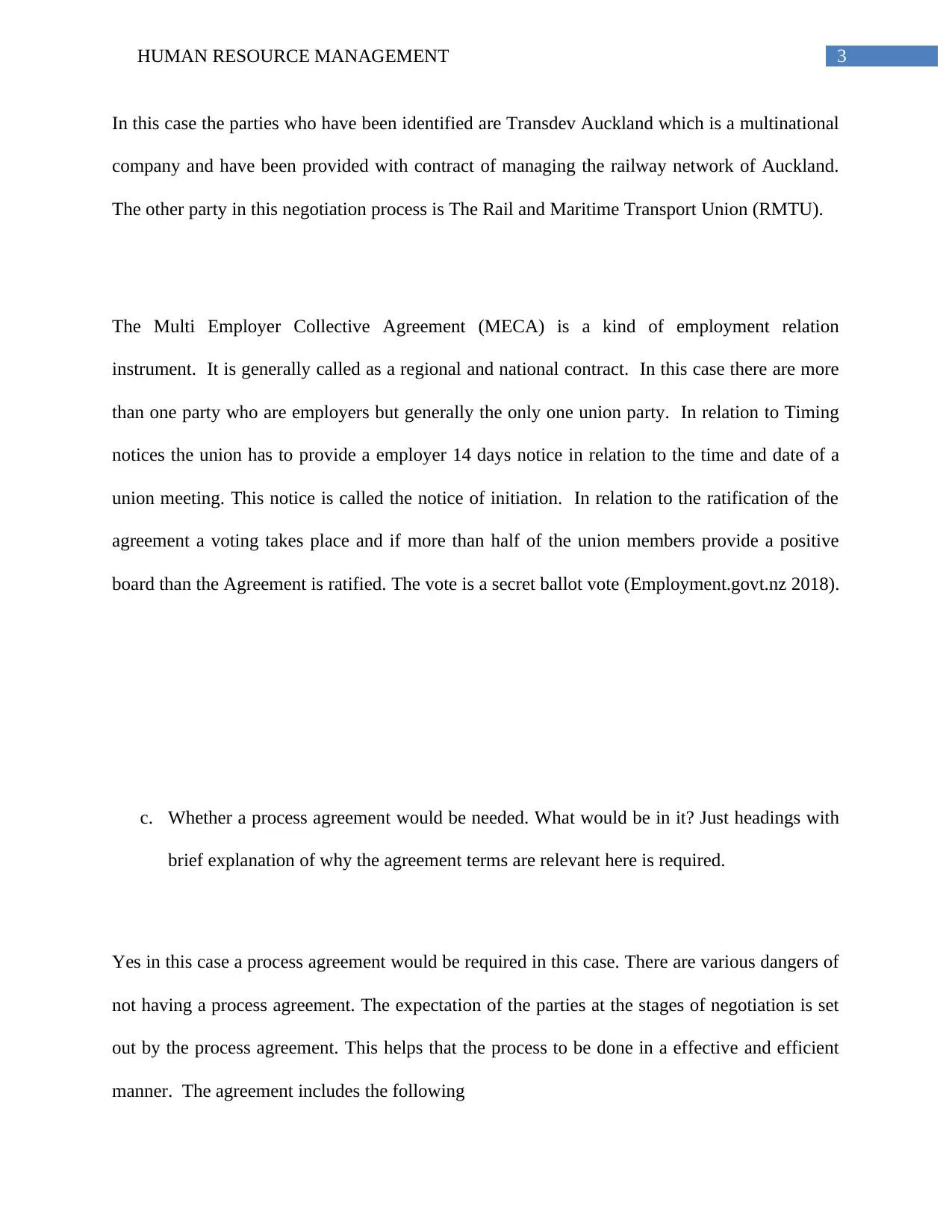
3HUMAN RESOURCE MANAGEMENT
In this case the parties who have been identified are Transdev Auckland which is a multinational
company and have been provided with contract of managing the railway network of Auckland.
The other party in this negotiation process is The Rail and Maritime Transport Union (RMTU).
The Multi Employer Collective Agreement (MECA) is a kind of employment relation
instrument. It is generally called as a regional and national contract. In this case there are more
than one party who are employers but generally the only one union party. In relation to Timing
notices the union has to provide a employer 14 days notice in relation to the time and date of a
union meeting. This notice is called the notice of initiation. In relation to the ratification of the
agreement a voting takes place and if more than half of the union members provide a positive
board than the Agreement is ratified. The vote is a secret ballot vote (Employment.govt.nz 2018).
c. Whether a process agreement would be needed. What would be in it? Just headings with
brief explanation of why the agreement terms are relevant here is required.
Yes in this case a process agreement would be required in this case. There are various dangers of
not having a process agreement. The expectation of the parties at the stages of negotiation is set
out by the process agreement. This helps that the process to be done in a effective and efficient
manner. The agreement includes the following
In this case the parties who have been identified are Transdev Auckland which is a multinational
company and have been provided with contract of managing the railway network of Auckland.
The other party in this negotiation process is The Rail and Maritime Transport Union (RMTU).
The Multi Employer Collective Agreement (MECA) is a kind of employment relation
instrument. It is generally called as a regional and national contract. In this case there are more
than one party who are employers but generally the only one union party. In relation to Timing
notices the union has to provide a employer 14 days notice in relation to the time and date of a
union meeting. This notice is called the notice of initiation. In relation to the ratification of the
agreement a voting takes place and if more than half of the union members provide a positive
board than the Agreement is ratified. The vote is a secret ballot vote (Employment.govt.nz 2018).
c. Whether a process agreement would be needed. What would be in it? Just headings with
brief explanation of why the agreement terms are relevant here is required.
Yes in this case a process agreement would be required in this case. There are various dangers of
not having a process agreement. The expectation of the parties at the stages of negotiation is set
out by the process agreement. This helps that the process to be done in a effective and efficient
manner. The agreement includes the following
Paraphrase This Document
Need a fresh take? Get an instant paraphrase of this document with our AI Paraphraser
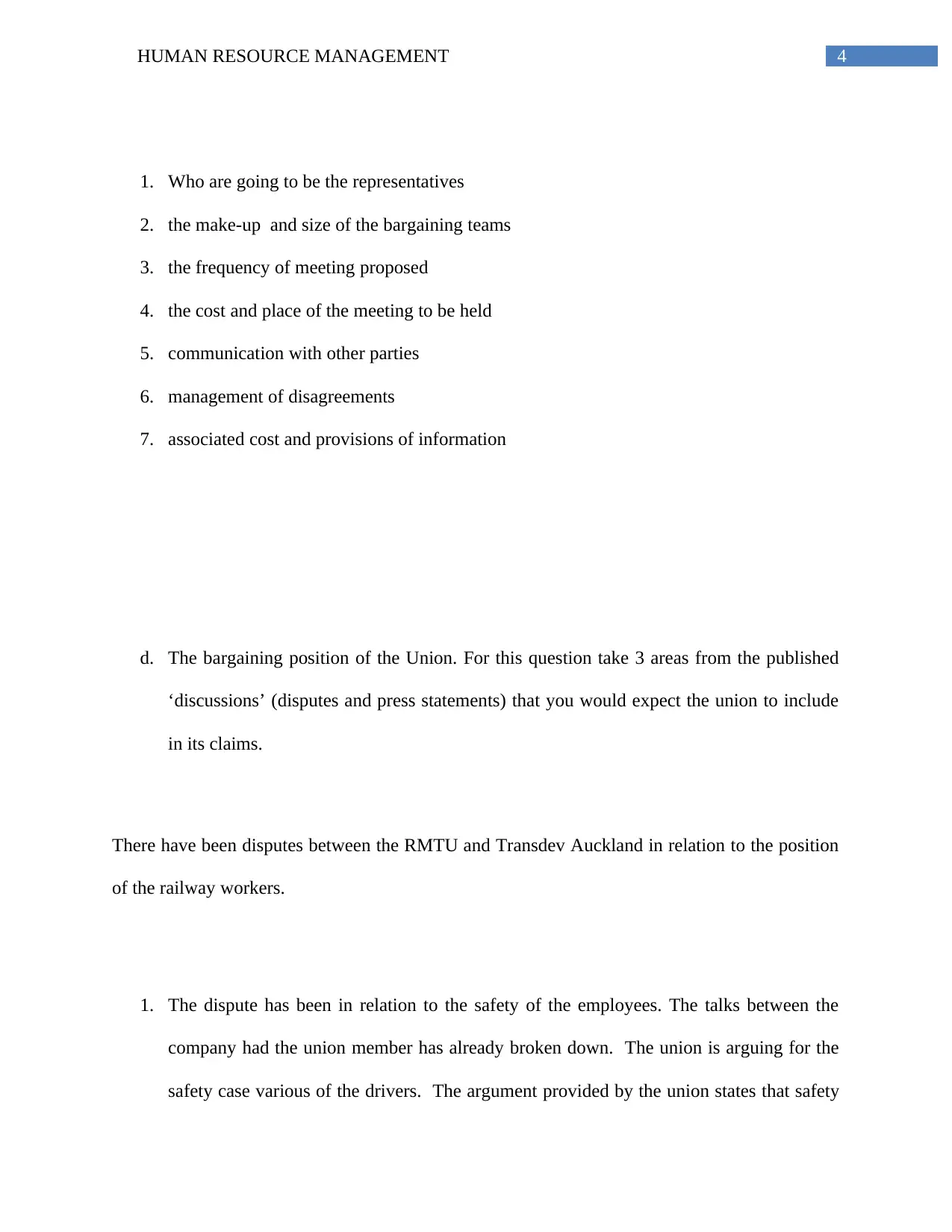
4HUMAN RESOURCE MANAGEMENT
1. Who are going to be the representatives
2. the make-up and size of the bargaining teams
3. the frequency of meeting proposed
4. the cost and place of the meeting to be held
5. communication with other parties
6. management of disagreements
7. associated cost and provisions of information
d. The bargaining position of the Union. For this question take 3 areas from the published
‘discussions’ (disputes and press statements) that you would expect the union to include
in its claims.
There have been disputes between the RMTU and Transdev Auckland in relation to the position
of the railway workers.
1. The dispute has been in relation to the safety of the employees. The talks between the
company had the union member has already broken down. The union is arguing for the
safety case various of the drivers. The argument provided by the union states that safety
1. Who are going to be the representatives
2. the make-up and size of the bargaining teams
3. the frequency of meeting proposed
4. the cost and place of the meeting to be held
5. communication with other parties
6. management of disagreements
7. associated cost and provisions of information
d. The bargaining position of the Union. For this question take 3 areas from the published
‘discussions’ (disputes and press statements) that you would expect the union to include
in its claims.
There have been disputes between the RMTU and Transdev Auckland in relation to the position
of the railway workers.
1. The dispute has been in relation to the safety of the employees. The talks between the
company had the union member has already broken down. The union is arguing for the
safety case various of the drivers. The argument provided by the union states that safety
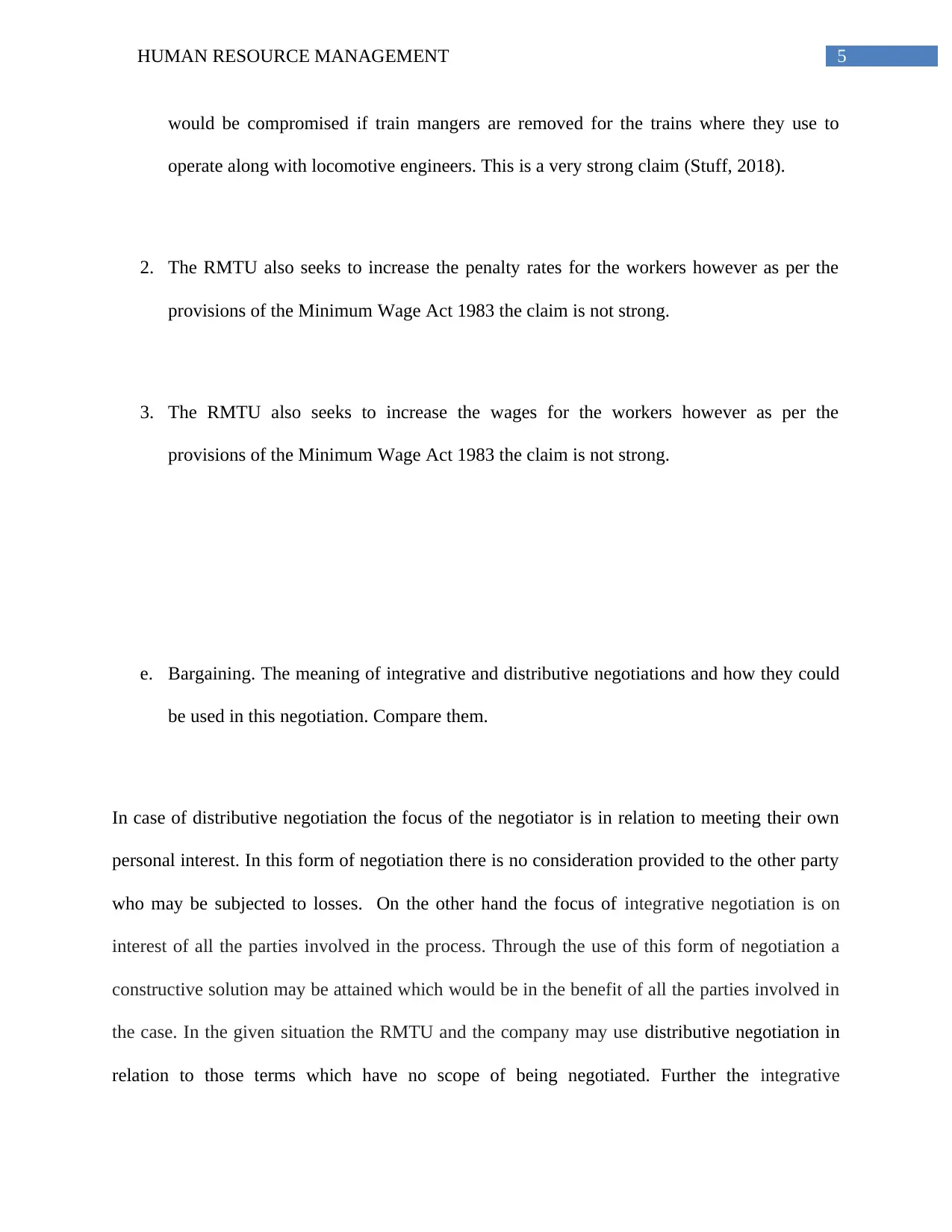
5HUMAN RESOURCE MANAGEMENT
would be compromised if train mangers are removed for the trains where they use to
operate along with locomotive engineers. This is a very strong claim (Stuff, 2018).
2. The RMTU also seeks to increase the penalty rates for the workers however as per the
provisions of the Minimum Wage Act 1983 the claim is not strong.
3. The RMTU also seeks to increase the wages for the workers however as per the
provisions of the Minimum Wage Act 1983 the claim is not strong.
e. Bargaining. The meaning of integrative and distributive negotiations and how they could
be used in this negotiation. Compare them.
In case of distributive negotiation the focus of the negotiator is in relation to meeting their own
personal interest. In this form of negotiation there is no consideration provided to the other party
who may be subjected to losses. On the other hand the focus of integrative negotiation is on
interest of all the parties involved in the process. Through the use of this form of negotiation a
constructive solution may be attained which would be in the benefit of all the parties involved in
the case. In the given situation the RMTU and the company may use distributive negotiation in
relation to those terms which have no scope of being negotiated. Further the integrative
would be compromised if train mangers are removed for the trains where they use to
operate along with locomotive engineers. This is a very strong claim (Stuff, 2018).
2. The RMTU also seeks to increase the penalty rates for the workers however as per the
provisions of the Minimum Wage Act 1983 the claim is not strong.
3. The RMTU also seeks to increase the wages for the workers however as per the
provisions of the Minimum Wage Act 1983 the claim is not strong.
e. Bargaining. The meaning of integrative and distributive negotiations and how they could
be used in this negotiation. Compare them.
In case of distributive negotiation the focus of the negotiator is in relation to meeting their own
personal interest. In this form of negotiation there is no consideration provided to the other party
who may be subjected to losses. On the other hand the focus of integrative negotiation is on
interest of all the parties involved in the process. Through the use of this form of negotiation a
constructive solution may be attained which would be in the benefit of all the parties involved in
the case. In the given situation the RMTU and the company may use distributive negotiation in
relation to those terms which have no scope of being negotiated. Further the integrative
⊘ This is a preview!⊘
Do you want full access?
Subscribe today to unlock all pages.

Trusted by 1+ million students worldwide
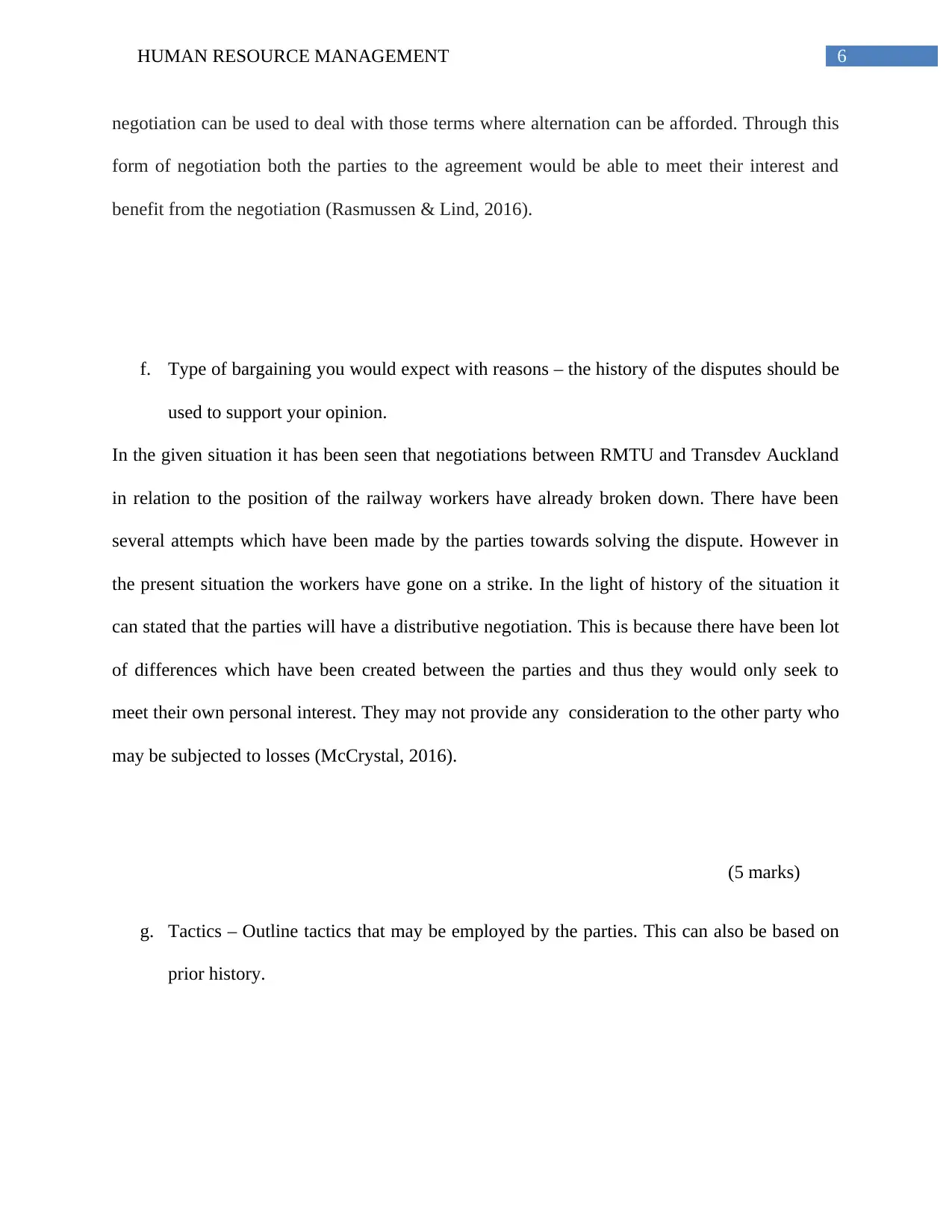
6HUMAN RESOURCE MANAGEMENT
negotiation can be used to deal with those terms where alternation can be afforded. Through this
form of negotiation both the parties to the agreement would be able to meet their interest and
benefit from the negotiation (Rasmussen & Lind, 2016).
f. Type of bargaining you would expect with reasons – the history of the disputes should be
used to support your opinion.
In the given situation it has been seen that negotiations between RMTU and Transdev Auckland
in relation to the position of the railway workers have already broken down. There have been
several attempts which have been made by the parties towards solving the dispute. However in
the present situation the workers have gone on a strike. In the light of history of the situation it
can stated that the parties will have a distributive negotiation. This is because there have been lot
of differences which have been created between the parties and thus they would only seek to
meet their own personal interest. They may not provide any consideration to the other party who
may be subjected to losses (McCrystal, 2016).
(5 marks)
g. Tactics – Outline tactics that may be employed by the parties. This can also be based on
prior history.
negotiation can be used to deal with those terms where alternation can be afforded. Through this
form of negotiation both the parties to the agreement would be able to meet their interest and
benefit from the negotiation (Rasmussen & Lind, 2016).
f. Type of bargaining you would expect with reasons – the history of the disputes should be
used to support your opinion.
In the given situation it has been seen that negotiations between RMTU and Transdev Auckland
in relation to the position of the railway workers have already broken down. There have been
several attempts which have been made by the parties towards solving the dispute. However in
the present situation the workers have gone on a strike. In the light of history of the situation it
can stated that the parties will have a distributive negotiation. This is because there have been lot
of differences which have been created between the parties and thus they would only seek to
meet their own personal interest. They may not provide any consideration to the other party who
may be subjected to losses (McCrystal, 2016).
(5 marks)
g. Tactics – Outline tactics that may be employed by the parties. This can also be based on
prior history.
Paraphrase This Document
Need a fresh take? Get an instant paraphrase of this document with our AI Paraphraser
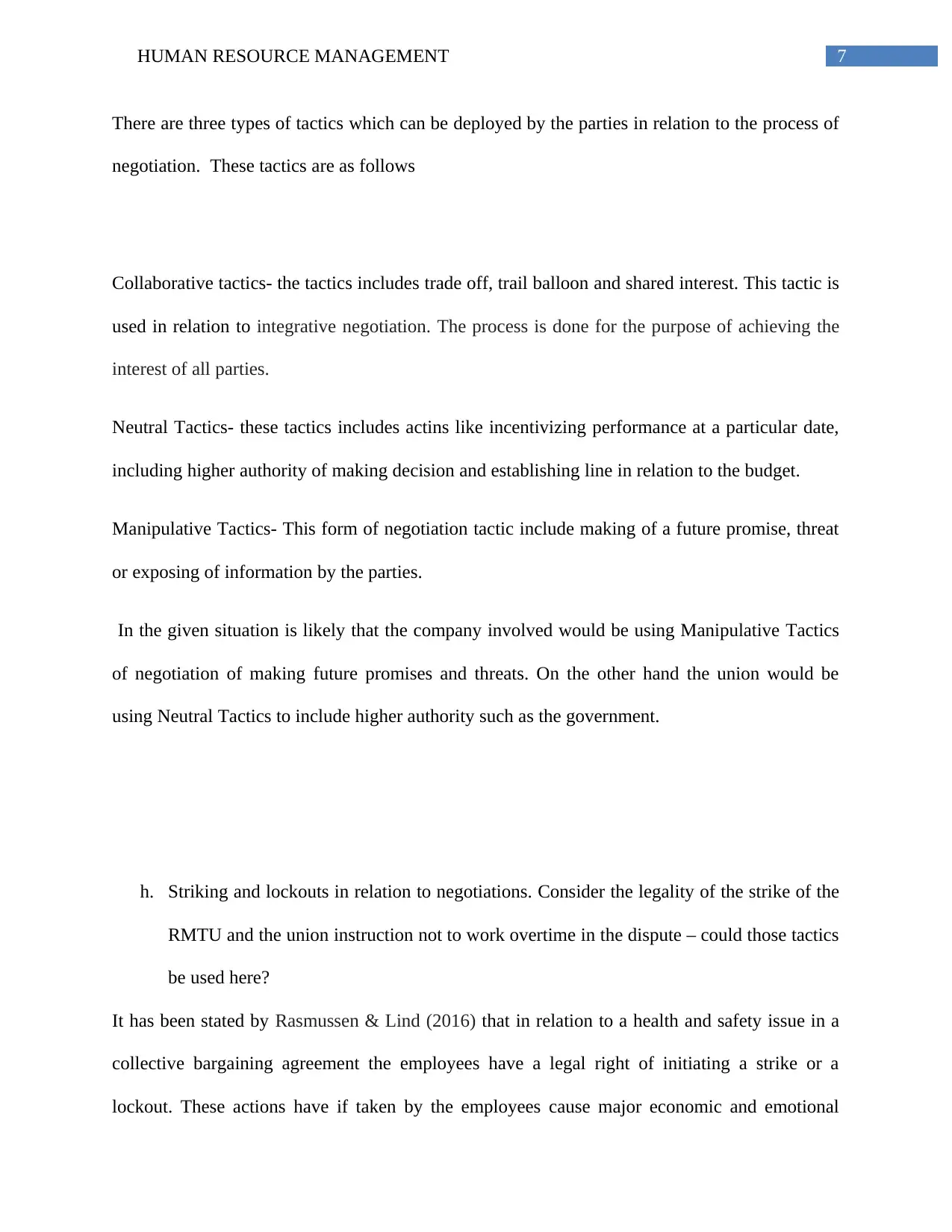
7HUMAN RESOURCE MANAGEMENT
There are three types of tactics which can be deployed by the parties in relation to the process of
negotiation. These tactics are as follows
Collaborative tactics- the tactics includes trade off, trail balloon and shared interest. This tactic is
used in relation to integrative negotiation. The process is done for the purpose of achieving the
interest of all parties.
Neutral Tactics- these tactics includes actins like incentivizing performance at a particular date,
including higher authority of making decision and establishing line in relation to the budget.
Manipulative Tactics- This form of negotiation tactic include making of a future promise, threat
or exposing of information by the parties.
In the given situation is likely that the company involved would be using Manipulative Tactics
of negotiation of making future promises and threats. On the other hand the union would be
using Neutral Tactics to include higher authority such as the government.
h. Striking and lockouts in relation to negotiations. Consider the legality of the strike of the
RMTU and the union instruction not to work overtime in the dispute – could those tactics
be used here?
It has been stated by Rasmussen & Lind (2016) that in relation to a health and safety issue in a
collective bargaining agreement the employees have a legal right of initiating a strike or a
lockout. These actions have if taken by the employees cause major economic and emotional
There are three types of tactics which can be deployed by the parties in relation to the process of
negotiation. These tactics are as follows
Collaborative tactics- the tactics includes trade off, trail balloon and shared interest. This tactic is
used in relation to integrative negotiation. The process is done for the purpose of achieving the
interest of all parties.
Neutral Tactics- these tactics includes actins like incentivizing performance at a particular date,
including higher authority of making decision and establishing line in relation to the budget.
Manipulative Tactics- This form of negotiation tactic include making of a future promise, threat
or exposing of information by the parties.
In the given situation is likely that the company involved would be using Manipulative Tactics
of negotiation of making future promises and threats. On the other hand the union would be
using Neutral Tactics to include higher authority such as the government.
h. Striking and lockouts in relation to negotiations. Consider the legality of the strike of the
RMTU and the union instruction not to work overtime in the dispute – could those tactics
be used here?
It has been stated by Rasmussen & Lind (2016) that in relation to a health and safety issue in a
collective bargaining agreement the employees have a legal right of initiating a strike or a
lockout. These actions have if taken by the employees cause major economic and emotional
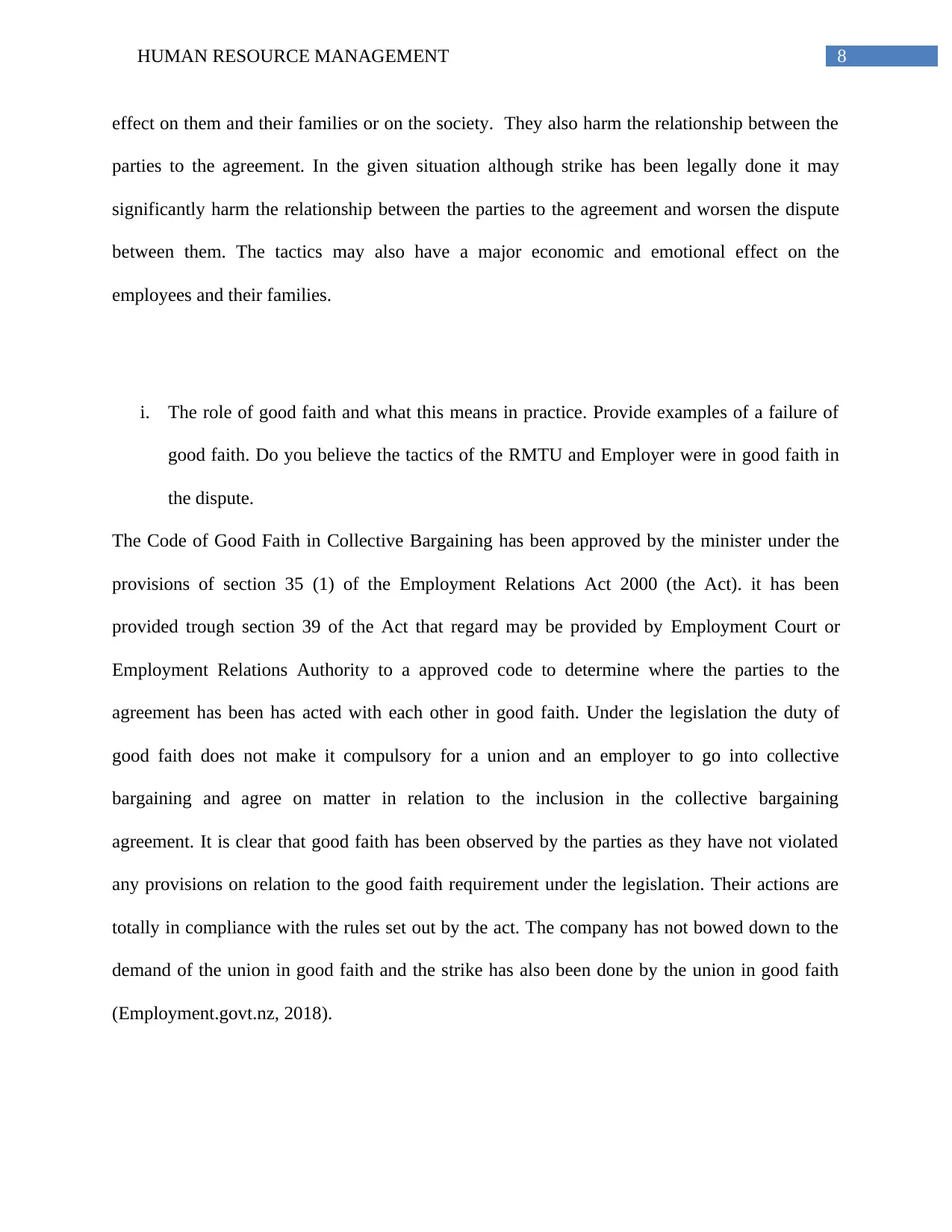
8HUMAN RESOURCE MANAGEMENT
effect on them and their families or on the society. They also harm the relationship between the
parties to the agreement. In the given situation although strike has been legally done it may
significantly harm the relationship between the parties to the agreement and worsen the dispute
between them. The tactics may also have a major economic and emotional effect on the
employees and their families.
i. The role of good faith and what this means in practice. Provide examples of a failure of
good faith. Do you believe the tactics of the RMTU and Employer were in good faith in
the dispute.
The Code of Good Faith in Collective Bargaining has been approved by the minister under the
provisions of section 35 (1) of the Employment Relations Act 2000 (the Act). it has been
provided trough section 39 of the Act that regard may be provided by Employment Court or
Employment Relations Authority to a approved code to determine where the parties to the
agreement has been has acted with each other in good faith. Under the legislation the duty of
good faith does not make it compulsory for a union and an employer to go into collective
bargaining and agree on matter in relation to the inclusion in the collective bargaining
agreement. It is clear that good faith has been observed by the parties as they have not violated
any provisions on relation to the good faith requirement under the legislation. Their actions are
totally in compliance with the rules set out by the act. The company has not bowed down to the
demand of the union in good faith and the strike has also been done by the union in good faith
(Employment.govt.nz, 2018).
effect on them and their families or on the society. They also harm the relationship between the
parties to the agreement. In the given situation although strike has been legally done it may
significantly harm the relationship between the parties to the agreement and worsen the dispute
between them. The tactics may also have a major economic and emotional effect on the
employees and their families.
i. The role of good faith and what this means in practice. Provide examples of a failure of
good faith. Do you believe the tactics of the RMTU and Employer were in good faith in
the dispute.
The Code of Good Faith in Collective Bargaining has been approved by the minister under the
provisions of section 35 (1) of the Employment Relations Act 2000 (the Act). it has been
provided trough section 39 of the Act that regard may be provided by Employment Court or
Employment Relations Authority to a approved code to determine where the parties to the
agreement has been has acted with each other in good faith. Under the legislation the duty of
good faith does not make it compulsory for a union and an employer to go into collective
bargaining and agree on matter in relation to the inclusion in the collective bargaining
agreement. It is clear that good faith has been observed by the parties as they have not violated
any provisions on relation to the good faith requirement under the legislation. Their actions are
totally in compliance with the rules set out by the act. The company has not bowed down to the
demand of the union in good faith and the strike has also been done by the union in good faith
(Employment.govt.nz, 2018).
⊘ This is a preview!⊘
Do you want full access?
Subscribe today to unlock all pages.

Trusted by 1+ million students worldwide
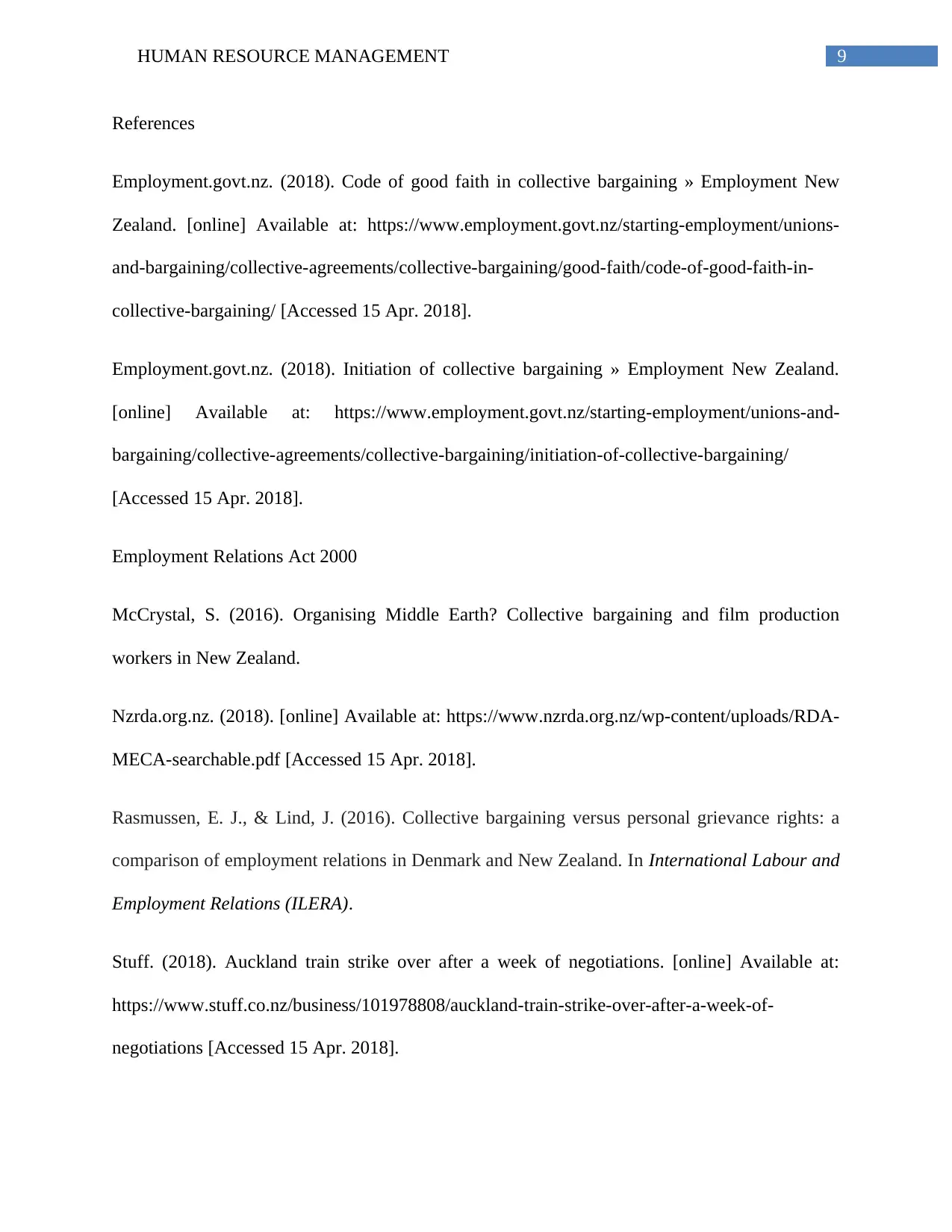
9HUMAN RESOURCE MANAGEMENT
References
Employment.govt.nz. (2018). Code of good faith in collective bargaining » Employment New
Zealand. [online] Available at: https://www.employment.govt.nz/starting-employment/unions-
and-bargaining/collective-agreements/collective-bargaining/good-faith/code-of-good-faith-in-
collective-bargaining/ [Accessed 15 Apr. 2018].
Employment.govt.nz. (2018). Initiation of collective bargaining » Employment New Zealand.
[online] Available at: https://www.employment.govt.nz/starting-employment/unions-and-
bargaining/collective-agreements/collective-bargaining/initiation-of-collective-bargaining/
[Accessed 15 Apr. 2018].
Employment Relations Act 2000
McCrystal, S. (2016). Organising Middle Earth? Collective bargaining and film production
workers in New Zealand.
Nzrda.org.nz. (2018). [online] Available at: https://www.nzrda.org.nz/wp-content/uploads/RDA-
MECA-searchable.pdf [Accessed 15 Apr. 2018].
Rasmussen, E. J., & Lind, J. (2016). Collective bargaining versus personal grievance rights: a
comparison of employment relations in Denmark and New Zealand. In International Labour and
Employment Relations (ILERA).
Stuff. (2018). Auckland train strike over after a week of negotiations. [online] Available at:
https://www.stuff.co.nz/business/101978808/auckland-train-strike-over-after-a-week-of-
negotiations [Accessed 15 Apr. 2018].
References
Employment.govt.nz. (2018). Code of good faith in collective bargaining » Employment New
Zealand. [online] Available at: https://www.employment.govt.nz/starting-employment/unions-
and-bargaining/collective-agreements/collective-bargaining/good-faith/code-of-good-faith-in-
collective-bargaining/ [Accessed 15 Apr. 2018].
Employment.govt.nz. (2018). Initiation of collective bargaining » Employment New Zealand.
[online] Available at: https://www.employment.govt.nz/starting-employment/unions-and-
bargaining/collective-agreements/collective-bargaining/initiation-of-collective-bargaining/
[Accessed 15 Apr. 2018].
Employment Relations Act 2000
McCrystal, S. (2016). Organising Middle Earth? Collective bargaining and film production
workers in New Zealand.
Nzrda.org.nz. (2018). [online] Available at: https://www.nzrda.org.nz/wp-content/uploads/RDA-
MECA-searchable.pdf [Accessed 15 Apr. 2018].
Rasmussen, E. J., & Lind, J. (2016). Collective bargaining versus personal grievance rights: a
comparison of employment relations in Denmark and New Zealand. In International Labour and
Employment Relations (ILERA).
Stuff. (2018). Auckland train strike over after a week of negotiations. [online] Available at:
https://www.stuff.co.nz/business/101978808/auckland-train-strike-over-after-a-week-of-
negotiations [Accessed 15 Apr. 2018].
1 out of 10
Related Documents
Your All-in-One AI-Powered Toolkit for Academic Success.
+13062052269
info@desklib.com
Available 24*7 on WhatsApp / Email
![[object Object]](/_next/static/media/star-bottom.7253800d.svg)
Unlock your academic potential
Copyright © 2020–2025 A2Z Services. All Rights Reserved. Developed and managed by ZUCOL.





